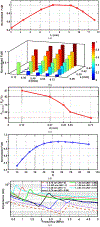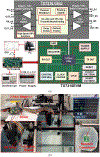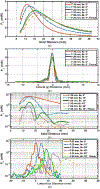Design and Optimization of Ultrasonic Links With Phased Arrays for Wireless Power Transmission to Biomedical Implants
- PMID: 34986100
- PMCID: PMC9131469
- DOI: 10.1109/TBCAS.2022.3140591
Design and Optimization of Ultrasonic Links With Phased Arrays for Wireless Power Transmission to Biomedical Implants
Abstract
Ultrasound (US) is an attractive modality for wireless power transfer (WPT) to biomedical implants with millimeter (mm) dimensions. To compensate for misalignments in WPT to a mm-sized implant (or powering a network of mm-sized implants), a US transducer array should electronically be driven in a beamforming fashion (known as US phased array) to steer focused US beams at different locations. This paper presents the theory and design methodology of US WPT links with phased arrays and mm-sized receivers (Rx). For given constraints imposed by the application and fabrication, such as load (RL) and focal distance (F), the optimal geometries of a US phased array and Rx transducer, as well as the optimal operation frequency (fc) are found through an iterative design procedure to maximize the power transfer efficiency (PTE). An optimal figure of merit (FoM) related to PTE is proposed to simplify the US array design. A design example of a US link is presented and optimized for WPT to a mm-sized Rx with a linear array. In measurements, the fabricated 16-element array (10.9×9×1.7 mm3) driven by 100 V pulses at fc of 1.1 MHz with optimal delays for focusing at F = 20 mm generated a US beam with a pressure output of 0.8 MPa. The link could deliver up to 6 mW to a ∼ 1 mm3 Rx with a PTE of 0.14% (RL = 850 Ω). The beam steering capability of the array at -45o to 45o angles was also characterized.
Figures


















References
-
- Chen K, Yang Z, Hoang L, Weiland J, Humayun M, and Liu W, “An integrated 256-channel epiretinal prosthesis,” IEEE J. Solid State Cir, vol. 45, pp. 1946–1956, Sep. 2010.
-
- McConnell G, Rees H, Levey A, Gutekunst C, Gross R, and Bellamkonda R, “Implanted neural electrodes cause chronic, local inflammation that is correlated with local neurodegeneration,” J. Neural Eng, vol. 6, p. 056003, Oct. 2009. - PubMed
-
- Sekhon B, “Bioelectronic medicine/electroceuticals – The emergence of new electronic therapeutics,” Int. J. Nov. Res. Eng. Pharm. Sci, vol 1, pp. 58–63, Mar. 2014.
-
- Jow U and Ghovanloo M, “Design and optimization of printed spiral coils for efficient transcutaneous inductive power transmission,” IEEE Trans. Biomed. Cir. Syst, vol. 1, pp. 193–202, Sept. 2007. - PubMed

